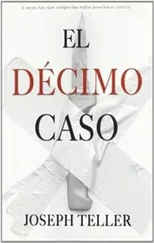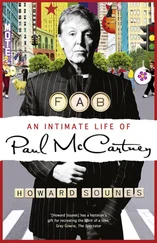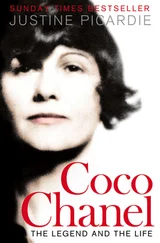The commentators were intrigued by Gabrielle’s capacity to be “beguiling and consistent without being monotonous. Witness her endless variety within narrow limits.” There were reports of long, straight coats of light wool or silk crepe, lined, for example, with a printed crepe used again for the simple frock underneath. (This was one of Gabrielle’s clever methods of simplification and would become a Chanel trademark.) Another detail that became a signature element was Gabrielle’s introduction of the camellia flower, probably first used in 1922, embroidered on a blouse.
The flower had both exotic and forbidden associations. Alexander Dumas’ passionate story La Dame aux camélias was a favorite of Gabrielle’s, and wearing a camellia had been widely recognized as a signal that a woman was available for seduction. Proust had worn a camellia in homage to Verdi’s La Traviata, itself inspired by Dumas’ novel, and this may in turn have inspired Gabrielle. The camellia has the added advantage of being without scent, and hence would not compete with Gabrielle’s perfumes. By 1924, material renderings of the flower were often added to her clothes.
Meanwhile, Vogue described “straight taffeta evening coats… gorgeous with all-over embroidery and fur collars. The slender frocks worn under them are often beaded. They have a new, deep, oval décolletage in the back.” (That deep décolletage at the back, and the short, beaded and fringed dresses that became so representative of the twenties are all innovations said to have originated with Gabrielle.)
Showing that she was eminently capable of using precious materials such as silk, crepe, satin, chiffon, lace and beading, Gabrielle also continued with her innovative use of jersey, including the most novel introduction of Scottish Fair Isle tricot. Indeed, she took up this comfortable knitted fabric, smooth on one side, with greater texture on the reverse, more than any other designer. Her almost austere elegance suited perfectly the fluid movement of this material, and her use of plain and patterned tricots was most instrumental in promoting the belief that Gabrielle’s particular kind of casualness was tremendously chic. The great push toward more “active” clothes for women was not hers alone, but she was undoubtedly one of its first and most important proponents. (As early as 1921, Gabrielle had set up a “Sports” workshop.)
Gabrielle herself was never anything but slim, but she apparently devoted a good deal of time and trouble to ensuring that she remained so. She joined wholeheartedly in the custom of visiting health spas for reducing and cleansing “cures.” From one of these establishments, Gabrielle wrote to Antoinette Bernstein that she was “tired of resting… I think only of fighting against Fat. I feel completely stupefied,” and hoped to “profit” by her self-imposed ordeal. 19
It is said that in the summer of 1923, Gerald and Sara Murphy persuaded the Hôtel du Cap at Antibes to remain open for the summer months. Gabrielle and her artist friends, including Picasso, the audacious and sociable Polish painter Moise Kisling, and Cocteau, had discovered Saint-Tropez, an as yet unspoiled fishing village, some time before, but the opening of the Hôtel du Cap during the summer set in motion the transformation of the area. Until then, the luxurious hotels and villas on the Riviera had their main season in winter and spring. In high summer, all the seaside resorts traditionally closed their doors to avoid the heat. We remember that Gabrielle went south with Dmitri Pavlovich in March, and the hotel where they stayed closed down in May. With the advent of a high-summer season by the sea, sunbathing now became high style. Gabrielle was certainly one of the first to sport a tan (although her friend Marthe Davelli had already taken to it during the First World War).
Gabrielle is so often credited with initiating something, such as cutting her hair short or introducing short skirts, because she had become the quintessence of high fashion. She had an unerring instinct for the moment, and what she did was now noticed and emulated. When as long ago as 1908, the dancer with the wild private life, Caryathis, had chopped off her hair in a fit of pique, most had thought her outrageous and unattractively eccentric. But when Gabrielle cut her hair several years later, in 1917, her timing, as always, was exactly right, and everyone followed suit. By the twenties, what Gabrielle wore, where she went, what sport she took up, how she entertained herself was of interest to the fashionable rich. This included sunbathing. From Saint-Jean-de-Luz, by the sea, Gabrielle wrote to a friend, “I was ill at first but I think it is because I ate too much which is quite disgusting! We’ve had terrible heat and my poor women [her seamstresses] were in a lamentable state, with sunburns which makes them rather ugly. I looked like a crayfish myself.” 20Eventually, thousands would follow.
In December 1923, the Parisian avant-garde was rattled when its prodigy Raymond Radiguet suddenly died. The boy’s book The Devil in the Flesh had become so popular it was even sold on street corners and at train stations, and it had made him famous. Reading France had fallen in love with Radiguet, and was appalled at the speed and premature nature of his demise. He had contracted typhoid when by the sea with friends, then, back in Paris, had once again fled Cocteau to a hotel across town. Here he picked up a girl and lived with her intermittently while revising his second book, Count d’Orgel’s Ball. Radiguet became wracked with chills, and the doctor diagnosed pneumonia. Cocteau was skeptical and called Gabrielle, who immediately sent her own doctor to the patient. He saw at once that it was typhoid and also that it was too late; he sent Radiguet to a hospital all the same. Radiguet’s mother misguidedly left his bedside for the night and in her absence he died, alone. Cocteau neither spent that last night with him, nor would he see him dead, or even attend the funeral.
As always, opinion was divided over Cocteau. Did he behave like “a self-indulgent queen,” or was he so devastated it was best that he keep away? Gabrielle had paid for the doctor, and now she also arranged and paid for the entire funeral, described as “most wonderfully done.” Artistic Paris turned out in force. Valentine Hugo wrote, “We were in utter despair” watching the white coffin, white hearse and white flowers, with just one bunch of red roses. It was all to Gabrielle’s design. The mourners followed in a long procession down the boulevard toward Père-Lachaise, the cemetery already harboring so many fellow writers.
Meanwhile, for several months past, Gabrielle had been spending time with another writer.
The date is lost, but at some point around 1922, Gabrielle had begun another affair, this time with Picasso’s old friend the poet Pierre Reverdy.
Reverdy was friend to many of the painters and poets of prewar Montmartre, on its hilltop in northern Paris. When they joined the postwar artistic exodus for Montparnasse, the new Montmartre in the southern part of the city, Reverdy stayed behind. With Max Jacob and the wild modernist poet Guillaume Apollinaire, in 1916 Reverdy had founded one of the most progressive and significant literary magazines of its day, the short-lived Nord-Sud. The name referred to the Metro line linking those two artistic Parisian domains, whose inhabitants had fought over modernity within the covers of Reverdy’s magazine.
His great friend Georges Braque believed that while almost no French poets had understood the first thing about modern art, Reverdy was “almost the only exception.” Indeed, Reverdy’s publication on Picasso was one of the few that the artist himself admired. Reverdy was both attracted and repelled by the smart snobberies of the haut monde, famously saying that he preferred the company of artists, and that “life in society is one huge adventure in piracy and cannot be successful without a great deal of conniving.”
Читать дальше












